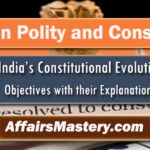Set 1 | Important Indian Constitution Evolution MCQs
Important Indian Constitution Evolution MCQs. The way the Indian Constitution has evolved over time plays a huge role in shaping Indian Polity and Governance, and it’s one of those things that really lays the groundwork for doing well in competitive exams—whether it’s Civil Services, State exams, SSC, Railways, Banking, or any of the others out there. Diving deep into Indian Polity, Constitution, and governance isn’t just about memorizing facts or ticking boxes for exams, but more about developing the kind of awareness that can make navigating these challenging exams a little less overwhelming and a lot more manageable.
| MCQs on Indian Constitution Evolution – Objective Questions and Answers |

Q1. The Cabinet Mission to India was headed by : (Asst. Grade 1992)
[A] Stafford Cripps
[B] A.V. Alexander
[C] Lord Pethick Lawrence
[D] Hugh Gaitskell
View Explanation
Correct Answer is C.
- The Cabinet Mission to India, which was sent by the British Government in 1946 to discuss and plan for the transfer of power from British rule to Indian leadership, was headed by three British Cabinet members.
- The mission was led by Lord Pethick-Lawrence, the Secretary of State for India. The other two members of the mission were Sir Stafford Cripps, President of the Board of Trade, and A.V. Alexander, the First Lord of the Admiralty.
Q2. The Constitution of India was adopted by the: (Teachers’ Exam 1994)
[A] Governor General
[B] British Parliament
[C] Constituent Assembly
[D] Parliament of India
View Explanation
Correct Answer is C.
- The Constituent Assembly of India adopted the Constitution of India on November 26, 1949, and it came into effect on January 26, 1950.
Q3. The Constituent Assembly for undivided India first met on
[A] 6th December, 1946
[B] 9th December, 1946
[C] 20th February, 1947
[D] 3rd June, 1947
View Explanation
Correct Answer is B.
- The Constituent Assembly of undivided India held its first meeting on December 9, 1946, in New Delhi. Dr. Sachchidananda Sinha was appointed as the temporary president of the Assembly.
Q4. Who among the following was the Constitutional adviser to the Constituent Assembly of India? (CDS 1995)
[A] Dr. B.N. Rao
[B] Dr. B.R. Ambedkar
[C] K.M. Munshi
[D] M.C. Setalvad
View Explanation
Correct Answer is A.
- B. N. Rau (Benegal Narsing Rau) was the Constitutional Adviser to the Constituent Assembly of India. He played a crucial role in drafting the Constitution by preparing its initial draft, which was later refined by the Drafting Committee, chaired by Dr. B.R. Ambedkar.
Q5. Who presided over the inaugural meeting of the Constituent Assembly of India?
[A] Sachidananda Sinha
[B] B. R. Ambedkar
[C] Dr. Rajendra Prasad
[D] P. Upendra
View Explanation
Correct Answer is A.
- Dr. Sachchidananda Sinha was appointed as the temporary president of the Constituent Assembly of India and presided over its inaugural meeting on 9th December 1946. Later, Dr. Rajendra Prasad was elected as the permanent president of the Assembly.
Q6. Which Act of British Parliament abolished the East India Company monopoly over trade in India? (Uttarakhand P.C.S. (Pre) 2016)
[A] Regulating Act
[B] Pitt’s India Act
[C] Charter Act of 1813
[D] None of the above
View Explanation
Correct Answer is C.
- The Charter Act of 1813 abolished the monopoly of the East India Company over trade in India, except for trade in tea and trade with China, which remained under its control. This act allowed private traders to participate in Indian trade under certain regulations.
Q7. By which of the following Act, Legislative Council of India received the power to discuss the budget? (U.P. P.C.S (Pre) 2003)
[A] Indian Council Act, 1861
[B] Indian Council Act, 1892
[C] Indian Council Act, 1909
[D] Indian Council Act, 1919
View Explanation
Correct Answer is B.
- The Indian Council Act of 1892 granted the Legislative Council of India the power to discuss the budget and question the executive on certain matters.
- However, it did not give them the power to vote on the budget. This act was an important step toward legislative reforms in British India.
Q8. In which of the following Acts, the provision was made for the establishment of Supreme Court at Calcutta? (U.P.P.C.S. (Mains) 2010)
[A] Regulating Act, 1773
[B] Pitt’s India Act, 1784
[C] Charter Act, 1813
[D] Charter Act, 1833
View Explanation
Correct Answer is A.
- The Regulating Act of 1773 made provisions for the establishment of the Supreme Court at Calcutta in 1774. It was the first British court in India with jurisdiction over British subjects and officials in Bengal, Bihar, and Orissa.
- The court had original and appellate jurisdiction and was meant to administer British laws in India.
Q9. With reference to the establishment of Supreme Court, which of the statement is/are correct? (U.P. R.O./A.R.O. (Pre) (Re-Exam) 2016)
1. Supreme Court at Calcutta was established by the Regulating Act of 1773.
2. Lemaister was the first Chief Justice of this Court.
Codes :
[A] 1 only
[B] 2 only
[C] Both 1 and 2
[D] Neither 1 nor 2
View Explanation
Correct Answer is A.
- Statement 1: ✅ Correct – The Supreme Court at Calcutta was established in 1774 under the Regulating Act of 1773. It was the first British Supreme Court in India, with jurisdiction over British subjects in Bengal, Bihar, and Orissa.
- Statement 2: ❌ Incorrect – The first Chief Justice of the Supreme Court at Calcutta was Sir Elijah Impey, not Lemaister.
Q10. By which one of the following Acts was the Federal Court in India created? (U.P.P.C.S. (Pre) 2014)
[A] Indian Council Act, 1861
[B] Government of India Act, 1909
[C] Government of India Act, 1919
[D] None of the above
View Explanation
Correct Answer is D.
- The Federal Court of India came into existence on 1st October 1937, and this was all because of the Government of India Act, 1935, which laid down the foundation for it. This court was meant to serve as the highest judicial authority in British India, handling disputes between provinces and interpreting the law as needed.
- The very first person to take charge as the Chief Justice of this newly formed court was Sir Maurice Gwyer, a man who played a key role in shaping the legal system during that time. If we talk about the correct answer, then it would definitely be option (d).
Related articles:
- Set 2 | Important Indian Constitution Evolution
- Set 3 | Important Indian Constitution Evolution
- Set 4 | Important Indian Constitution Evolution
- Set 5 | Important Indian Constitution Evolution
- Set 6 | Important Indian Constitution Evolution
- Set 7 | Important Indian Constitution Evolution
- Set 8 | Important Indian Constitution Evolution



